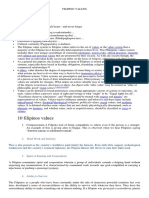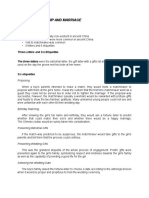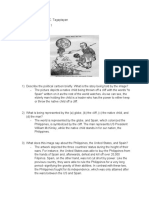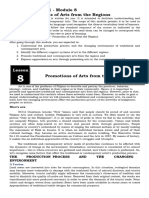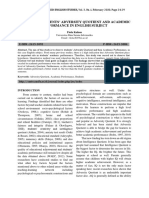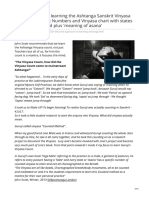0 ratings0% found this document useful (0 votes)
324 viewsPAGMAMANO
PAGMAMANO
Uploaded by
Jessica Asis1. Pagmamano, also known as mano, is a Filipino gesture of respect performed by touching one's forehead to an elder's palm as a way to receive a blessing and show respect for elders and family values.
2. The tradition dates back to precolonial times and is shared by other Southeast Asian countries like Indonesia and Malaysia, originating from Arabic customs.
3. In the Philippines today, mano is still used as a sign of respect for elders, especially those two or more generations older, and it is considered impolite not to perform the gesture when greeting elders.
Copyright:
© All Rights Reserved
Available Formats
Download as PPTX, PDF, TXT or read online from Scribd
PAGMAMANO
PAGMAMANO
Uploaded by
Jessica Asis0 ratings0% found this document useful (0 votes)
324 views15 pages1. Pagmamano, also known as mano, is a Filipino gesture of respect performed by touching one's forehead to an elder's palm as a way to receive a blessing and show respect for elders and family values.
2. The tradition dates back to precolonial times and is shared by other Southeast Asian countries like Indonesia and Malaysia, originating from Arabic customs.
3. In the Philippines today, mano is still used as a sign of respect for elders, especially those two or more generations older, and it is considered impolite not to perform the gesture when greeting elders.
Original Description:
One of Philippine culture is Pagmamano
Copyright
© © All Rights Reserved
Available Formats
PPTX, PDF, TXT or read online from Scribd
Share this document
Did you find this document useful?
Is this content inappropriate?
1. Pagmamano, also known as mano, is a Filipino gesture of respect performed by touching one's forehead to an elder's palm as a way to receive a blessing and show respect for elders and family values.
2. The tradition dates back to precolonial times and is shared by other Southeast Asian countries like Indonesia and Malaysia, originating from Arabic customs.
3. In the Philippines today, mano is still used as a sign of respect for elders, especially those two or more generations older, and it is considered impolite not to perform the gesture when greeting elders.
Copyright:
© All Rights Reserved
Available Formats
Download as PPTX, PDF, TXT or read online from Scribd
Download as pptx, pdf, or txt
0 ratings0% found this document useful (0 votes)
324 views15 pagesPAGMAMANO
PAGMAMANO
Uploaded by
Jessica Asis1. Pagmamano, also known as mano, is a Filipino gesture of respect performed by touching one's forehead to an elder's palm as a way to receive a blessing and show respect for elders and family values.
2. The tradition dates back to precolonial times and is shared by other Southeast Asian countries like Indonesia and Malaysia, originating from Arabic customs.
3. In the Philippines today, mano is still used as a sign of respect for elders, especially those two or more generations older, and it is considered impolite not to perform the gesture when greeting elders.
Copyright:
© All Rights Reserved
Available Formats
Download as PPTX, PDF, TXT or read online from Scribd
Download as pptx, pdf, or txt
You are on page 1of 15
Pagmamano
Pagmamano
Mano, also known as pagmamano, is a Filipino
"honoring-gesture" performed as a symbol of
respect for elders and as a manner of receiving a
blessing from them. The person providing the
greeting bows towards the elder's hand and rubs
their forehead on the elder's palm, similar to hand-
kissing. It is frequently directed toward people who
are two generations or older. The fundamental
reason behind this custom is that family is highly
valued in Filipino society.
The word mano is Spanish for hand while the
word po is often used in Filipino culture and language
at the end of each sentence as a sign of respect when
addressing someone older, akin to English (sir/ma'am).
Put together, mano po literally translates to [your]
hand please as the greeting initiates the gesture of
touching the back of the hand of an elder lightly on
one’s forehead. In Visayas the gesture is
called amin and it is called siklod in Kapampangan.An
identical tradition is followed in neighbouring
Indonesia and Malaysia called salim
and salam respectively, suggesting that the mano
Origin
of Pagmamano
The custom of mano is dated to precolonial times,
and is still followed by the related countries of
Indonesia, Malaysia and Brunei, which the
Philippines shares a common ethnolinguistical origin
with. In these countries however, the custom is
called salim originating from Arabic. Salim is also
done in the family to respect elder family members
and relatives. Salim is also a normal gesture done in a
traditional Islamic society to respect
the ulama (religious elite/scholars)
In today's Philippine setting…
The mano is still used by Filipinos as a sign of respect to their
elders. It is usually done when the elder is seen for the first time in
the day or upon entering a house or gathering. There is no age limit
for the usage of the mano, but it is usually practiced on those older
by two generations or more.
By offering your hand to mano, you are allowing yourself to be
subservient to the elder to accept their blessing and wisdom. It is
considered impolite if one does not exercise the custom
of pagmamano when entering the home of an elder or after seeing
them at a gathering
The respect for elders stems from the high value of family in
Filipino culture. Filipinos are loyal to their family, such that the
elderly live in the homes of their children and/or grandchildren to
be taken care of, and the nursing home business is almost
Though the mano po gesture is usually practiced on one's parents,
grandparents, uncles, and aunts, it is not restricted to one’s relatives.
Godparents are often greeted this way as well. During the Spanish colonial era,
Catholic priests were also greeted this way alongside the European practice of
hand-kissing, and this still continues today often after a Catholic Mass, though
the latter has fallen out of use.
The reason why Filipinos mano elders although they are not necessarily a
relative is due to the value of family. Filipinos call older non-relatives
"grandfather/mother, aunt, uncle, etc." even when they are not actually related
in this way. By addressing elders in this way, you are acknowledging their age
and the respect you need to show them. It’s considered to be disrespectful to
call an elder just by their first name. [2] Hence, Filipinos treat friends and
acquaintances like family.[citation needed]
The mano po gesture is usually followed by a response of "God bless you"
or "May the Lord have mercy on you" by the elder; the sign of the cross may be
made over the recipient. The latter response of "May the Lord have mercy on
you" is used when the pagmamano is performed with both hands to ask an
Similar Filipino customs
Beso-beso
Though the mano po gesture is still widely used at
present in the Philippines, many Filipinos have also
replaced this gesture with the beso. The beso-
beso which originated from the Spanish word for kiss,
is a common greeting in the Philippines similar to
the mano. The beso-beso is a cheek-to-cheek kiss.
The beso is more commonly used amongst the upper
classes as a greeting to relatives and close friends, but
is not reserved for an older person unlike the mano
Po at opo
Similar to the mano po gesture, po and opo are also
distinctly Filipino ways of showing respect to one's elders.[9]
The po is usually affixed to the end of sentences or phrases
when one is addressing someone older than him or her. For
example, paumanhin in Filipino means sorry. To an elder, one
would say paumanhin po, The word po alone has origins as a
respectful honorific but in contemporary times, it does not
carry its past implications anymore besides its contemporary
meaning to add formality as a sign of respect. This is why it is
affixed to mano and thus is said as mano po when one is
requesting for the blessing of an elder.
End
You might also like
- The Yoga Wheel 2023Document110 pagesThe Yoga Wheel 2023Graceful Dandelion100% (2)
- Atg Dense Strenght ProgramDocument11 pagesAtg Dense Strenght Programlonegunman2405No ratings yet
- Iyengar Yoga Home Practice Sequences 1 PDFDocument4 pagesIyengar Yoga Home Practice Sequences 1 PDFYogesh Sharma100% (2)
- Volleyball One Day League Certificate SampleDocument8 pagesVolleyball One Day League Certificate SampleJohn Paul George EguiaNo ratings yet
- Position Paper 2Document3 pagesPosition Paper 2api-354599001No ratings yet
- Programming To WinDocument6 pagesProgramming To Winp300644No ratings yet
- 10 Filipinos Values: Values Value System Ideologies Moral Codes Ethical Practices Etiquette Cultural and Personal ValuesDocument5 pages10 Filipinos Values: Values Value System Ideologies Moral Codes Ethical Practices Etiquette Cultural and Personal Valuesgladys rubioNo ratings yet
- Magayon FestivalDocument30 pagesMagayon FestivalMe-AnneLucañasBertizNo ratings yet
- FolkdanceDocument3 pagesFolkdanceJessica May ChavezNo ratings yet
- TECHNOLOGy IN 21st CENTURYDocument5 pagesTECHNOLOGy IN 21st CENTURYJayson Mendez100% (1)
- Social Self: Relating Harmoniously and Property With EveryoneDocument5 pagesSocial Self: Relating Harmoniously and Property With EveryoneDanica Rose Daza MacahiloNo ratings yet
- Lesson 5 - The Physical and Sexual Self: Understanding The Self/ Compiled By: Minera Laiza C. Acosta 1Document11 pagesLesson 5 - The Physical and Sexual Self: Understanding The Self/ Compiled By: Minera Laiza C. Acosta 1Daylan Lindo MontefalcoNo ratings yet
- RambutanDocument1 pageRambutanKarl Collantes0% (1)
- Chinese Courtship and MarriageDocument3 pagesChinese Courtship and MarriagekmkzNo ratings yet
- Research Paper (Final)Document75 pagesResearch Paper (Final)kkkkkNo ratings yet
- GE 7 Activity 3Document3 pagesGE 7 Activity 3dhave albaricoNo ratings yet
- Contemporary Arts 12 Unit 3 PDFDocument12 pagesContemporary Arts 12 Unit 3 PDFyoojnsmNo ratings yet
- Mathematics in The Modern World: Number Sequence and SeriesDocument12 pagesMathematics in The Modern World: Number Sequence and SeriesCherrylane EdicaNo ratings yet
- Benefit of Paper, Cotton and Tissue Paper Wastes On Growth and Germination of Monggo Beans (Vigna Radiata)Document1 pageBenefit of Paper, Cotton and Tissue Paper Wastes On Growth and Germination of Monggo Beans (Vigna Radiata)Turvs Aulacam100% (1)
- Reviewer gr11Document4 pagesReviewer gr11Tin TwentysevenNo ratings yet
- Values 1Document13 pagesValues 1JaysonCruzNo ratings yet
- Lesson 9 Discussion Global DemographyDocument8 pagesLesson 9 Discussion Global DemographyMary Lou SouribioNo ratings yet
- ResearchDocument13 pagesResearchFrancilyn Ganisi SanchezNo ratings yet
- Surigao Del Sur State University: Republic of The PhilippinesDocument11 pagesSurigao Del Sur State University: Republic of The PhilippinesRicarte FernandezNo ratings yet
- Dance Panay Island Spaniards Philippines Spanish Bolero Mexican Jarabe TapatioDocument16 pagesDance Panay Island Spaniards Philippines Spanish Bolero Mexican Jarabe TapatioWilson Morano0% (1)
- Partido State University: G3-Contemporary WorldDocument7 pagesPartido State University: G3-Contemporary WorldEmmanuel GarciaNo ratings yet
- Philippine Politics and SportsDocument2 pagesPhilippine Politics and SportsNoel IV T. Borromeo100% (1)
- Describe The Political Cartoon BrieflyDocument1 pageDescribe The Political Cartoon BrieflySweet Angel 0721100% (1)
- Laro NG Lahi Thru Based ActivitiesDocument14 pagesLaro NG Lahi Thru Based ActivitiesGlen Lluz100% (1)
- David, Joshua B. - PE - Module 5 - ActivitiesDocument7 pagesDavid, Joshua B. - PE - Module 5 - ActivitiesHanah Grace GomezNo ratings yet
- Cebu Technological University: Republic of The Philippines Danao CampusDocument6 pagesCebu Technological University: Republic of The Philippines Danao CampusRiza Mae BayoNo ratings yet
- GE113 Module 1Document4 pagesGE113 Module 1Jean Ann Catanduanes100% (1)
- Quarter 1 - Module 8 Promotions of Arts From The Regions: LessonDocument8 pagesQuarter 1 - Module 8 Promotions of Arts From The Regions: Lessonkarlrubio03No ratings yet
- Duties and Responsibilities of AwardeesDocument56 pagesDuties and Responsibilities of AwardeesHanah AlvarezNo ratings yet
- A Study On Students' Adversity Quotient and Academic Performance in English SubjectDocument6 pagesA Study On Students' Adversity Quotient and Academic Performance in English SubjectJuan MiguelNo ratings yet
- PGMA's SONA 2004Document8 pagesPGMA's SONA 2004RG CruzNo ratings yet
- Written Speech (Public Speaking) INFORMATIVE SPEECH-Bautista AiriDocument3 pagesWritten Speech (Public Speaking) INFORMATIVE SPEECH-Bautista AiriAiri BautistaNo ratings yet
- Module 1 3july2019 (Nofooter) - Draft For CopyeditorDocument26 pagesModule 1 3july2019 (Nofooter) - Draft For Copyeditoraya camanggocNo ratings yet
- Readings 5 (Activities)Document3 pagesReadings 5 (Activities)Alexander RamirezNo ratings yet
- Soc 218 Week 1Document14 pagesSoc 218 Week 1MarkNo ratings yet
- Folk Dance 2Document16 pagesFolk Dance 2Kler DaradarNo ratings yet
- Lesson 3 - Physical Domain of Growth and DevelopmentDocument8 pagesLesson 3 - Physical Domain of Growth and DevelopmentShai SantinoNo ratings yet
- Lerion PacsonDocument30 pagesLerion PacsonJerome Mallari PacsonNo ratings yet
- Topic 10-ApplicationDocument2 pagesTopic 10-ApplicationHannah Alvarado Bandola0% (2)
- VisionDocument33 pagesVisionELLAJEAN GALLOGO0% (1)
- Chapter 5 SampleDocument16 pagesChapter 5 SampleLalaine Angel Alejo100% (1)
- GEE 3 MODULE 5 Popular Culture and The Media 2 Copy 1Document4 pagesGEE 3 MODULE 5 Popular Culture and The Media 2 Copy 1Angelica GazzinganNo ratings yet
- Samaon SulaimanDocument1 pageSamaon SulaimanReggy CapadaNo ratings yet
- Table 5.1. Local Environmental Problems and IssuesDocument13 pagesTable 5.1. Local Environmental Problems and IssuesFreddie BanagaNo ratings yet
- WWW - Studocu - Com - PH - Document - Southwestern University Phinma - Social Case Work - Validated 5 Physical Science Module 5 Version 2 - 15670843Document1 pageWWW - Studocu - Com - PH - Document - Southwestern University Phinma - Social Case Work - Validated 5 Physical Science Module 5 Version 2 - 15670843Joenald Kent OrdoñaNo ratings yet
- Camposalyannap (Module 2)Document4 pagesCamposalyannap (Module 2)Alyanna Clarisse Padilla CamposNo ratings yet
- Socsc 03Document24 pagesSocsc 03Emon Espejo100% (1)
- Prelims - Chapter 2: Mathematics Language and SymbolsDocument30 pagesPrelims - Chapter 2: Mathematics Language and SymbolsRose EnorNo ratings yet
- Consider Four Basic Food GroupsDocument3 pagesConsider Four Basic Food GroupsPrecious ViterboNo ratings yet
- Group #3 Art AppreciationDocument21 pagesGroup #3 Art AppreciationKurth AngelNo ratings yet
- Humanities Topic 2 2Document17 pagesHumanities Topic 2 2Dexter FernandezNo ratings yet
- Soul&SpaceDocument15 pagesSoul&SpaceSerious CHillerNo ratings yet
- Eng 2 Literature ReviewDocument5 pagesEng 2 Literature Reviewapi-583600507No ratings yet
- Reflection Paper - TallanoDocument2 pagesReflection Paper - Tallanoemchavez07No ratings yet
- Will The Earth Will Melt A Few Years From NowDocument2 pagesWill The Earth Will Melt A Few Years From NowPette Cy Madeja MontallanaNo ratings yet
- Bugtong: Literary Form ExampleDocument3 pagesBugtong: Literary Form ExampleIvy CalderonNo ratings yet
- Midterm Requirements Philippine Pop CultureDocument9 pagesMidterm Requirements Philippine Pop Culturekenken the ExplorerNo ratings yet
- H1Document5 pagesH1JesaAmon100% (1)
- Mano or PagmamanoDocument9 pagesMano or PagmamanoAnonymous tyEGT2RJJUNo ratings yet
- 5 3 1 CalculatorDocument24 pages5 3 1 CalculatorJohn ZimmermanNo ratings yet
- IPF Arab Cup Men S Classic Powerlifting Championships 2023 - Men ScoresheetDocument15 pagesIPF Arab Cup Men S Classic Powerlifting Championships 2023 - Men Scoresheetyohanaguirre06No ratings yet
- YIA - PreliminaryDocument123 pagesYIA - PreliminaryPatrícia Franchi de FreitasNo ratings yet
- Official Team Lineups Shakey's V-League Season XDocument10 pagesOfficial Team Lineups Shakey's V-League Season XEli Benjamin Nava TaclinoNo ratings yet
- Senior Girls SyllabusDocument13 pagesSenior Girls SyllabusnishantNo ratings yet
- Hand GesturesDocument12 pagesHand GesturesJoshua BarelaNo ratings yet
- A Week of Hard Labor Day 2 LegsDocument1 pageA Week of Hard Labor Day 2 Legswendel da costa nevesNo ratings yet
- Results - KZN Club Comp March 2023Document1 pageResults - KZN Club Comp March 2023Kiran KooverjeeNo ratings yet
- Eight Week Flexibility PlanDocument2 pagesEight Week Flexibility PlanThe GuardianNo ratings yet
- Mano or PagmamanoDocument9 pagesMano or PagmamanoAnonymous tyEGT2RJJUNo ratings yet
- Inhale-Exhale Inhale-Exhale Inhale-Exhale Inhale-ExhaleDocument3 pagesInhale-Exhale Inhale-Exhale Inhale-Exhale Inhale-Exhalelala2000_roNo ratings yet
- List of AsanasDocument8 pagesList of AsanascorneliuskooNo ratings yet
- Primary Sheet Ayc PDFDocument3 pagesPrimary Sheet Ayc PDFJuliana BarbosaNo ratings yet
- Sequence Mystic Body WorksDocument4 pagesSequence Mystic Body WorkskiberjaNo ratings yet
- Sun Salutation A Surya Namaskara ADocument2 pagesSun Salutation A Surya Namaskara AMilton CastrilloNo ratings yet
- Asanas by The Chakra PDFDocument4 pagesAsanas by The Chakra PDFSean Griffin100% (1)
- Indian-Review S Ramaswami PDFDocument146 pagesIndian-Review S Ramaswami PDFSornam RNo ratings yet
- Sheiko Modified Hypertrophy v4.0Document24 pagesSheiko Modified Hypertrophy v4.0gersaNo ratings yet
- Pimping Up Krishnamacharya's Life Saving Yoga Sequence Plus 8mm Vintage Video App For Iphone.Document11 pagesPimping Up Krishnamacharya's Life Saving Yoga Sequence Plus 8mm Vintage Video App For Iphone.AnthonyNo ratings yet
- Iyengar Sequences 2Document7 pagesIyengar Sequences 2shanmuga100% (7)
- One Approach To Learning The Ashtanga Sanskrit Vinyasa Count Sanskrit Numbers and Vinyasa Chart WithDocument14 pagesOne Approach To Learning The Ashtanga Sanskrit Vinyasa Count Sanskrit Numbers and Vinyasa Chart WithLaura GonzalezNo ratings yet
- 1 Week Exercise PlanDocument3 pages1 Week Exercise PlannatashahatcherNo ratings yet
- Strong by Bret Month 1 Workout LogDocument4 pagesStrong by Bret Month 1 Workout Logteinia100% (3)
- Ordinea AsanelorDocument2 pagesOrdinea Asanelorely_1510100% (2)






